Building a club-style DJ Mixer + turntable/media player setup instead of a DJ controller or all-in-one?
The mixer is the heart of your setup, but which one is best for you?
We asked David to put together this guide based on his deep-dive reviews of nearly every model available today. We kept our noses out of it, so you can trust there’s no salesmanship, just 100% honest, expert advice.
Use this guide to save weeks of research and get the right dj mixer for your needs and budget.
This Ultimate Guide was produced by David Michael at The Passionate DJ Podcast.
DJ Mixers We Reviewed: What to Expect
We compared the best club and festival-oriented mixers on the market, focusing on modern, in-production, four-channel mixers from major manufacturers.
This guide will help you pick the best mixer for your needs and budget so you can purchase from your favorite authorized dealer under full warranty (like The DJ Hookup, where you may even get a discount if you mention this review on live chat! #shamelessplug)
DJ Mixers We Didn’t Review
We didn’t cover two-channel scratch mixers (aka battle mixers) in this guide. Those will be discussed in a future guide.
Subscribe to Passionate DJ on Youtube or The DJ Hookup email newsletter so you don’t miss it.
We also didn’t focus on “boutique mixers” such as high-end rotary mixers produced by small manufacturers. Although they’re great, we haven’t spent enough time with them to include them in this guide.
Perhaps in the future, after we get some more time with them, we’ll create a rotary guide. Drop a comment if that would be of interest.
Lastly, this review doesn’t cover DJ Controllers or All-in-One Standalone DJ Systems. If you’re looking for either, check out the appropriate guide below:
- Best DJ Controllers 2024: Ultimate Guide
- Best All-in-One Standalone DJ Systems for 2024 – Ultimate Guide to No-Laptop, DJ Controller Alternatives
How to Select a Mixer
Determine Your Requirements
- Software/Platform
- Ports & Connections
- Budget
Additional Criteria
- Features
- Sound Quality
- Build Quality
The Best DJ Mixers for 2024
Pioneer DJ DJM-A9 (🔗Full Review Here )
“The Club Standard”
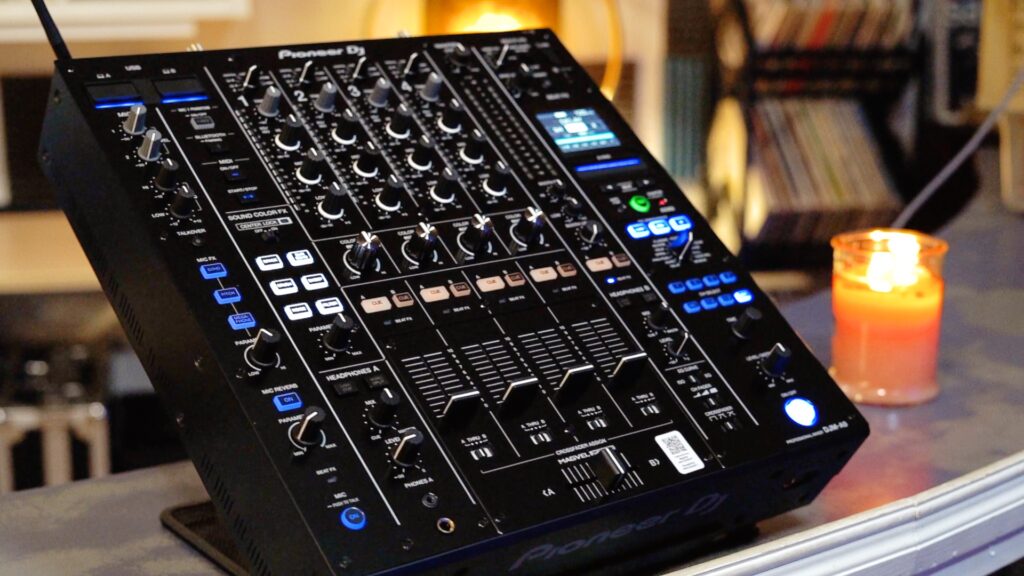
The DJM-A9 is the redefined club standard. It takes the iconic DJM-900nexus design into the modern era with impressive sound quality and new updates. The A9 features multiple improvements over its predecessor, raising the bar for four-channel club-standard mixers. While it’s a better piece of hardware, it remains familiar to those who loved the DJM club mixer for decades.
The A9 inherits the audio circuitry from the DJM-V10, which costs almost a grand more. While neither mixer is cheap, it’s nice to know that the best quality Pioneer DJ offers is available in this standard four-channel mixer.
Inside, you’ll find two high-end chips made by ESS Technology. The analog-to-digital converter brings in crystal-clear 32-bit audio with a very flat noise floor. The second chip converts the signal back from digital to analog, with impressive Dynamic Range (DNR) and extremely low Total Harmonic Distortion (THD) levels. These ESS converters are used in audiophile-grade gear, producing crisp, clear, and well-rounded sound that’s notably better than its predecessor.
The A9 has four line inputs, four phono inputs (for up to four turntables), typical XLR and RCA main outputs, a ¼” booth output, and a record output. There’s a full set of digital coax inputs and a main output to take full advantage of the 32-bit circuitry.
The phantom-powered input allows you to connect a high-quality condenser mic directly to the DJM-A9. There are three independent mic FX, plus a reverb, so you can modify your vocals without taking up a Beat FX slot. The faders are solid and feel nice, and a Magvel crossfader is included for those who want to scratch.
There is a rather precarious Bluetooth/Wi-Fi antenna that dangles off the back of the unit. I recommend disconnecting this for home use if it’s not being used. That said, Bluetooth connectivity is a nice touch.
My biggest complaint about the mixer might be its lack of a built-in Ethernet hub. There is a single jack here, but without a hub, you still need an external one for most setups. Like all flagship Pioneer mixers, the A9 feels very well built, though it’s larger than previous four-channel mixers from the company. It has a great-sounding output, a great-sounding mixing bus, and all the connectivity that any club or festival DJ needs.
The Pioneer DJM-A9 is a worthy successor to the DJM-900NXS2, though not a revolutionary one. But the “industry standard” mixer for festival and club installations received a major sound quality upgrade, which is undoubtedly a good thing.
Pioneer DJ DJM-V10 (🔗Full Review Here )
The All-Arounder
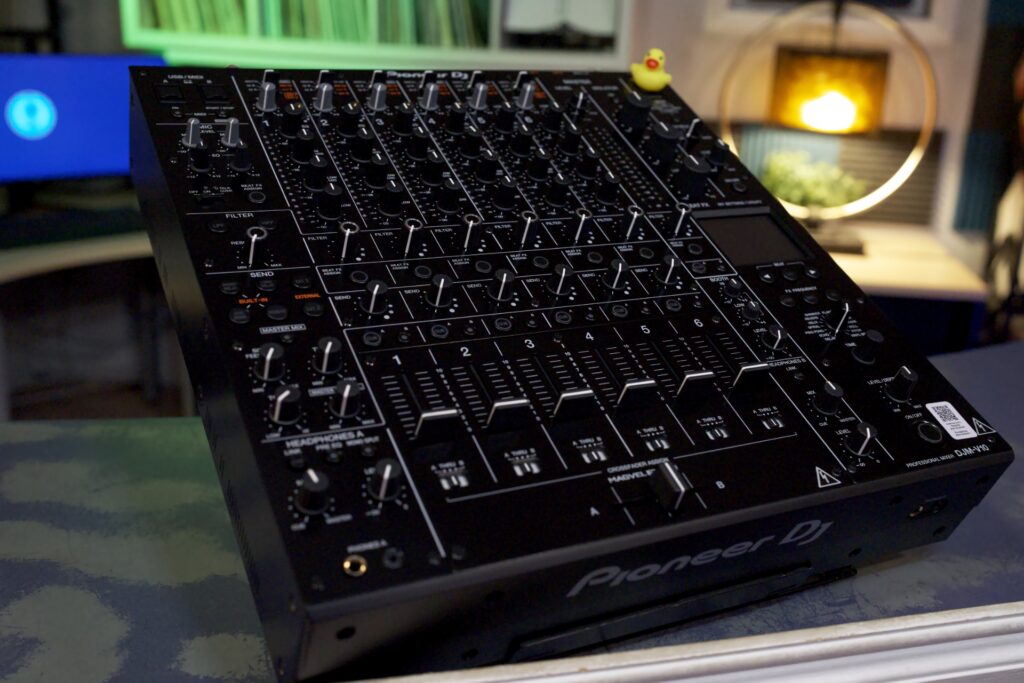
If you’re a DJ, or especially a DJ/live act hybrid, who wants to connect various types of sound sources and route them, and who cares about sound quality, this is the mixer for you. It enables you to get precise and surgical with your individual tracks and mix them how you want. Everything I just said about the A9 in terms of sound quality also applies here, as this is where that circuitry came from. The DJM-V10 sounds terrific, producing audio full of energy and presence.
The V10 is a six-channel mixer, which for many DJs is a lot! But again, this mixer is about helping you do whatever you want. In my original review, I called it a “Great Enabler.”
Due to the onboard compressors, I could squeeze new life into old vinyl records or 80s synthesizer noises, mix them with modern tracks, and have everything gel together. Plus, with a four-band EQ on each channel, you get even further control over each slice of the audio spectrum. Historically, this feature was only found on higher-end Allen & Heath mixers, so I found it to be a welcome addition.
It also has a very robust and great-sounding filter system. You can select low or high pass, adjust the amount of resonance, and apply it to any of the six channels or the overall master output. With the resonance turned down, you get really clean and crispy sounding filters, which are great to use as a mixing tool. When turned up, you get that squelchy Pioneer sound they are known for.
The DJM-V10 has a super high-quality suite of FX, just like the A9 and as is expected by a Pioneer DJ Club mixer. But it also has connections for two external SENDs and four built-in SEND FX. So, whether you want to do surgery to your mix on the board itself or send it out to other processors, guitar pedals, and bits-and-bobs, and return it back, this mixer is up to the task. There’s so much you can do with this mixer, and I demonstrate as much of it as I can in my original review video.
The V10’s biggest hurdle is its price. At $3,499, you’re truly paying a premium for all this versatility. It’s also offered as the V10-LF (which stands for “Long Faders”) for an additional $100. This version removes the crossfader and assignment buttons and replaces your channel faders with 60mm long ones.
Pioneer DJ DJM-750MK2
DJM-A9 Lite
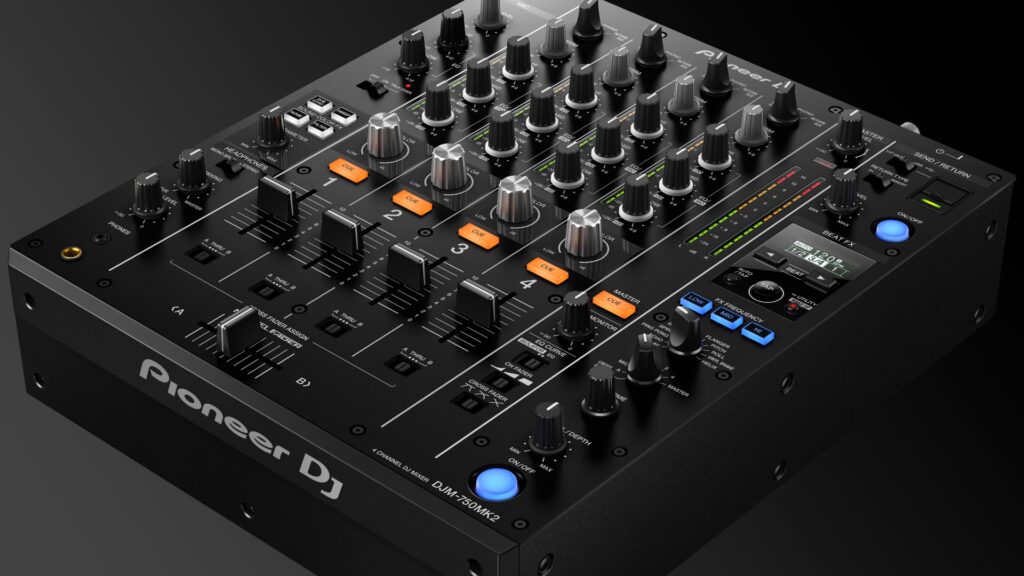
What if you want the essential Pioneer DJ club mixer experience but don’t have thousands to spend?
I call the 750MK2 the “Poor Man’s 900” or the “Poor Man’s A9” because it provides a very similar experience to the flagship mixers at a much more affordable price. The 750MK2 is also a great way to access Pioneer DJ’s iconic suite of FX without having to buy the latest top-end mixer.
That’s one thing you’ll find lacking in the remaining mixers on today’s list. Some have less robust FX, and some don’t have onboard FX at all. So, if good FX are more important to you than the fancy features and audiophile sound quality of the V10 or A9, the DJM-750MK2 is a solid choice.
Another thing to consider is that it comes with a high-quality Magvel crossfader, so if you need more than two channels but also scratch, this mixer is up to the task right out of the box.
The biggest disappointment about the 750MK2 might be its lack of Serato compatibility. If you need a way to unlock that software, this is not the mixer for you. It’s the only reason I’ve kept my old DJM-850 around, which is nearly the same mixer, but I need something that supports Serato.
However, it does unlock Rekordbox Performance mode and DVS, so if you’re already all-in on Pioneer DJ, no problem. Or, if you’re using XDJs or CDJs or some other source, also no problem.
For many DJs, this mixer is a much smarter choice than the A9, V10, or even an older 900NXS2. It takes that design, keeps everything that’s truly important, and strips away all the extraneous features you may not need if you’re not plugging into a 50,000W festival system every weekend.
If you’re an older DJ who grew up on a DJM-500 or 600, you’ll feel right at home with this mixer. If you’re used to a DJM-A9 or other modern Pioneer mixer but can’t justify spending that kind of money, you’ll also feel right at home with this mixer.
Allen & Heath XONE:96 (🔗Full Review Here )
The Precision Instrument
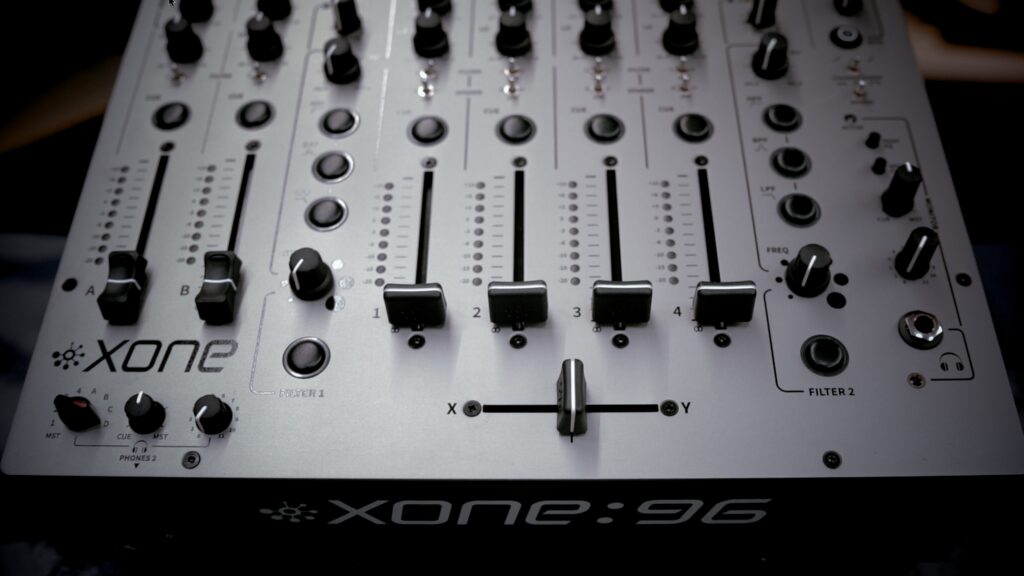
Allen & Heath hardware has been a mainstay of both studios and DJ booths worldwide. They introduced four-band EQs and industry-leading filters to the DJ mainstream many years ago, and it has become a staple of their flagship mixers ever since.
The XONE:96, like the V10, is designed to help you connect almost any kind of sound source you want, pick it apart, and mix it all together in a buttery-smooth mixing bus. The top of the mixer has a classic silver finish, giving it a somewhat industrial appearance. Everything you touch feels “meaty,” and the 60mm faders are extremely smooth.
There are no accusations of this mixer feeling cheap or gaudy. The finish and build quality are everything you expect from a top-tier Allen & Heath product.
It’s advertised as a 6+2 channel mixer. Unlike most DJ mixers on the market, it contains a four-band EQ instead of the usual three. Instead of a “mid” knob, it’s split into Hi Mid and Lo Mid, giving you an extra level of control.
You also won’t find any onboard FX. Instead, the XONE:96 has a very flexible Send/Return system so that you can add FX, sound processors, synths, or whatever your heart desires. Send 1 is switchable from Line to Hi-Z level, making it ideal for incorporating instrument level effects, like classic guitar pedals.
And of course, it has those legendary assignable A&H filters that everyone loves. Alongside the classic HPF, BPF, LPF, resonance control, and frequency sweep layout, there’s CRUNCH, a harmonic distortion effect that sits before the filter. Check out my full review video to hear what that sounds like.
The XONE:96 has impeccable sound quality. While it has USB ports, MIDI connectivity, and all the features you expect from a modern digital mixer, it’s high-end analog circuitry at its core. Essentially, they took the existing guts of the legendary XONE:92, latched a high-end 32-bit sound card on top of it, and brought it into the modern era for digital DJs.
Scratch DJs will be happy to know that it also includes an Innofader Mini, with a super sharp cut. This is truly a no-compromises mixer.
Allen & Heath XONE:92
The Pure Analog
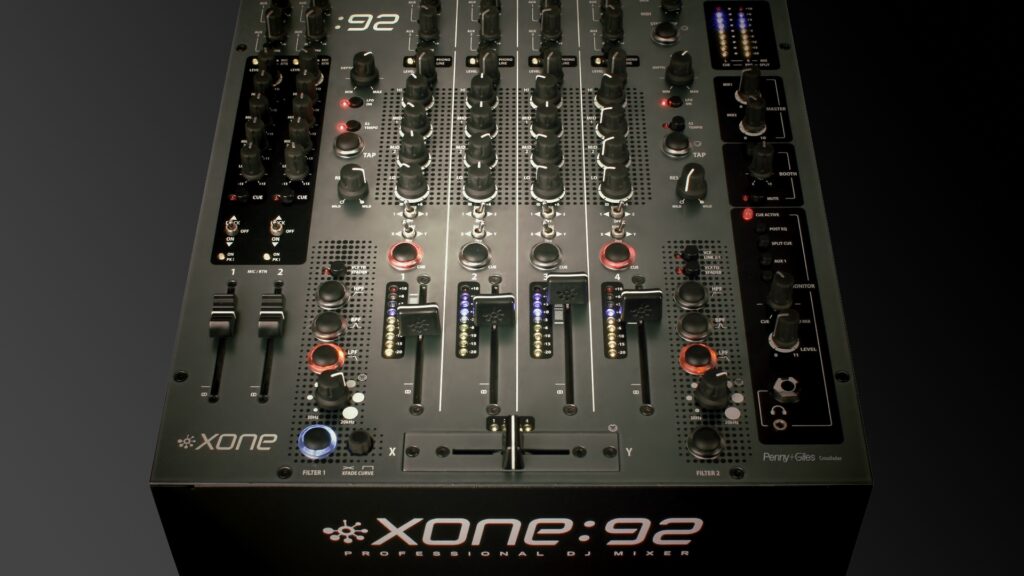
If sound cards aren’t your thing, the XONE:92 is still available. You can get the classic design, legendary filters, and everything else you love about the XONE, just without the digital connectivity.
This is a hardware mixer through and through, which might appeal to someone who doesn’t use DJ software at all. For example, you might be a “digital DJ” who uses CDJs, XDJs, or Denon DJ SC6000s as your players. Those would work just fine on this analog board. It also works for vinyl DJs, though it’s important to note that the 96 has much improved phono preamps, which get louder than the ones on the 92. So, if you play a lot of older records, you might struggle to bring them up to volume.
The XONE:92 is $1,799, and the XONE:96 is $2,499. So, neither of these mixers are cheap, but you’re definitely paying for quality, and the capability for the price is unmatched by its Pioneer DJ counterparts.
Denon DJ PRIME X1850
The Underdog
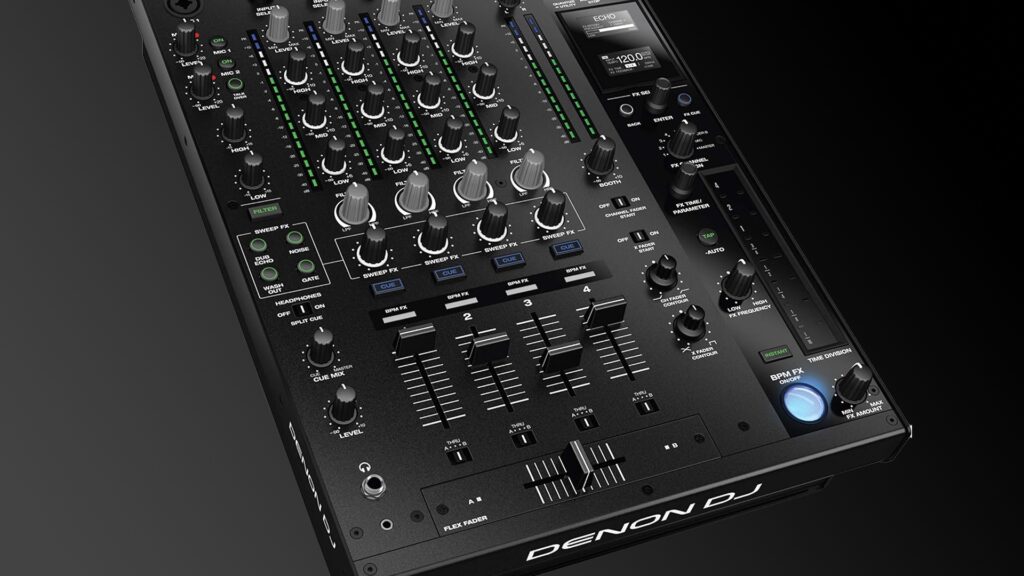
Denon DJ is good at providing affordable hardware alternatives. At $1,199, it’s one of the most affordable four-channel mixers on the market. And for this price, you get a ton of valuable features. For example, if you look at the back, you’ll see it has full digital coax connectivity, a send/receive system, a dual USB sound card, four phono inputs, and my personal favorite feature, the Ethernet hub.
Unlike some of the other mixers on this list, you also get a suite of onboard FX. The single-knob “Sweep FX,” the equivalent to Pioneer DJ’s “Color FX,” are separate from the filter knob. This is a nice touch because it means you don’t have to choose between the filter or these FX.
It also has 16 onboard “BPM FX,” which can be controlled with a touch strip and has a quantize function to keep it locked in time. Overall, it’s fantastic to have all these FX on a four-channel mixer at this price. But I must admit, they aren’t my favorite in the world. They don’t compare to the quality of Pioneer DJ FX, so don’t expect that.
But it’s the only mixer we’re discussing today with a built-in Ethernet hub. If your setup requires an Ethernet network for music sharing, this saves a LOT of wiring spaghetti. Running a separate powered hub for this sucks, and I wish more mixers had this.
The X1850 is an obvious choice if you’re an Engine OS user (e.g., you already have a set of Denon DJ players). Connect your players to the central mixer with the Ethernet hub, and everything gets along in harmony while matching that now-iconic green-and-black color scheme. The network carries tempo information, supports ultra-fast music file transfer, and provides StagelinQ audio/visual connections.
PLAYdifferently Model 1 & 1.4 (🔗Full Review Here )
The Nerd Option
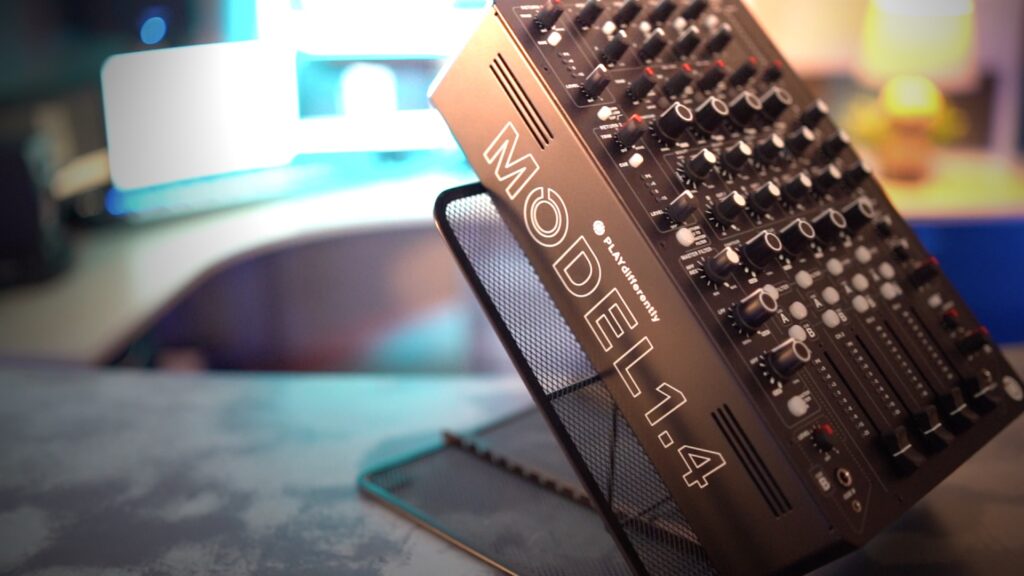
Rather than talk about who the Model 1 and 1.4 mixers are for, it’s easier to discuss who they are not for by examining what the mixer doesn’t have. Let’s take the crossfader, for example. There isn’t one. Nor is there a way to adjust the upfader curves. That rules out most hip-hop DJs or anyone who wants to scratch.
With no mic inputs, it’s clearly not meant for mobile DJs or anyone who needs to stop the music for an announcement. It has a robust send/return system, but this is used in place of onboard FX. It’s not aimed at DJs who like to work within the box. There is no flanger, spiral, reverb, or anything like that built into this mixer.
It also lacks an onboard sound card. There are no USB ports, thanks to a focus on fully analog circuitry. And MIDI? Don’t even think about it!
These mixers aren’t aimed at traditionalists. You’ll quickly notice there’s not even a typical LOW-MID-HI EQ on the individual channels. Other than the main mix, your audio-shaping duties will be performed by a set of resonance-free filters.
In my opinion, this is the perfect “love it or hate it” mixer. There are two kinds of DJ who find value in these mixers:
- Purists who want a fully analog experience (vinyl audiophiles)
- DJ/producers who like breaking songs into pieces to create something new
The PLAYdifferently mixers are intended to be used like musical instruments. And like a musical instrument, its intent is clear, specific, and limited. But for the right DJ, this mixer will be everything.
The Model 1/1.4 does not hold your hand. It provides a totally new way to think about sculpting your mix. The dual filters on each channel are brilliant, but the EQ might drive you crazy. It did for me. And yet, what a beautiful piece of kit that provides a lovely sonic output.
AlphaTheta euphonia (🔗Full Review Here )
The Rotary
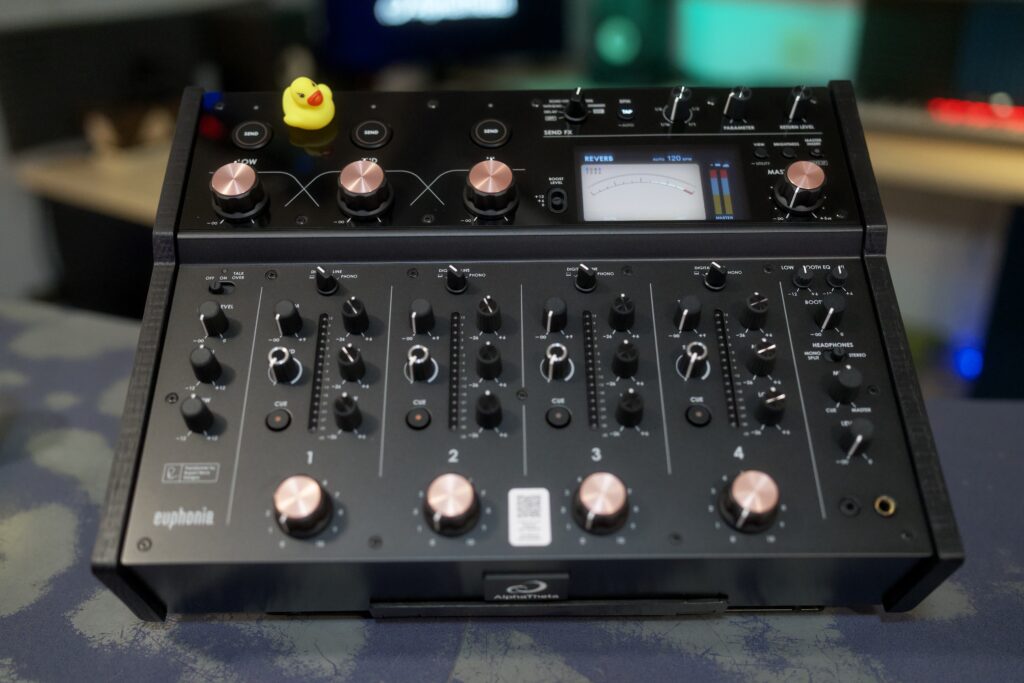
Further straying from the traditional club mixer layout, we have the euphonia – made by AlphaTheta (Pioneer DJ’s parent company). When I think of rotary mixers, I think about delicate blending, long transitions, analog warmth, and a minimalist design that focuses on smooth mixing. But I also tend to think of them as fairly limited in today’s digital world.
When using a rotary mixer, you often sign up for a device that doesn’t give you the technological benefits enjoyed by most DJs, such as onboard USB sound cards, high-resolution screens, or digital inputs for modern DJ decks. AlphaTheta solves this problem by offering a hybrid analog/digital rotary mixer.
It’s a simple, intuitive, and classy four-channel hardware mixer with an extreme focus on sound quality, both in terms of how it internally mixes tracks and the overall sound output. It contains a higher-grade digital/analog converter than even the DJM-V10 and A9. Through its hybrid design, all sound ultimately passes through an analog transformer circuit by the legendary Rupert Neve Designs.
And yes, the euphonia sounds absolutely amazing. During testing, it added a noticeable pleasing color to the music that wasn’t present when compared to a “normal” digital DJ mixer. On top of the way it sounds, the euphonia is meant to look and feel special. There is a high-quality display, but it’s fairly small and minimalist, displaying an emulation of multi-channel analog VU meters.
The sides are made out of painted wood, the knobs are finished in copper trim, and glossy surfaces meet matte finishes. It has a few FX, while providing a Send network for you to add your own. The overall design is delightfully un-fussy and embraces the hybrid nature of this mixer.
Undoubtedly, many of you would like me to compare it to other limited-run rotary mixers on the market. But the fact is, the euphonia brings something to the table that all those other boutique rotaries don’t: playability.
A rotary mixer usually comes with some level of compromise, mostly due to their analog nature. AlphaTheta has released a mixer that doesn’t require you to give up the convenience and usability of a digital setup while still adding a pleasing analog warmth to the entire mix bus. That said, it’s the most expensive mixer we’re discussing today while certainly not being the most versatile one.
Reloop RMX-95 (🔗Full Review Here )
The Frugal Alternative
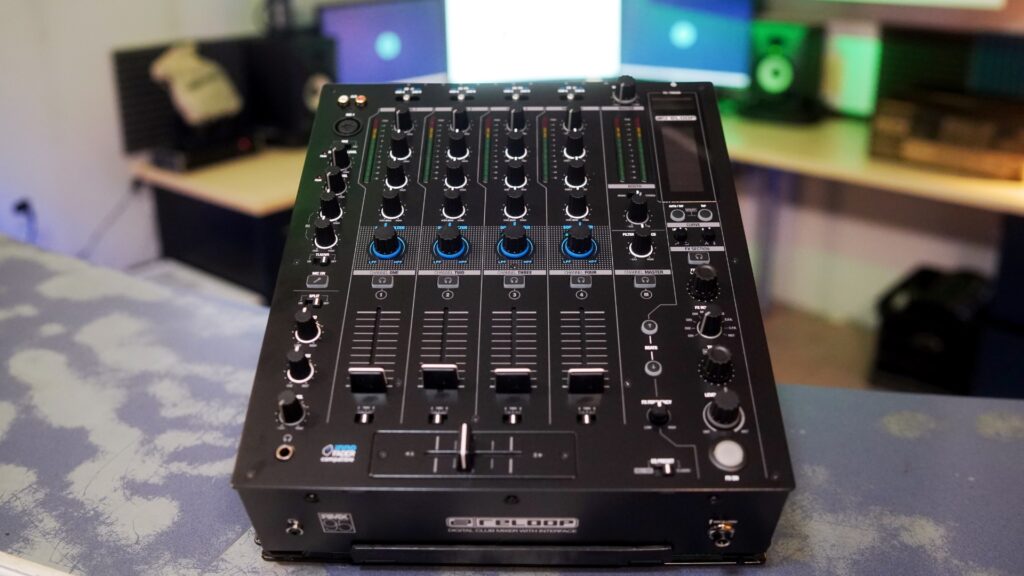
If you wander off the beaten path of DJ hardware companies, you’ll find a scrappy little outfit called Reloop. This company is good at finding holes in the market and filling those needs. The RMX95 is the least expensive four-channel mixer on today’s list, but it offers a lot of bang for its $1,100 price.
This type of product is a rarity in the DJ market these days. By that, I mean it’s a product that doesn’t try to sell itself on gimmicks or a feature set that prices it out of our budgets. It’s quite simply a good mixer.
What that means is you get decent build quality, all the main features and connectivity you need, and a dual USB sound card, but not a ton of bells and whistles. If you happen to use Algoriddim’s Djay software, this mixer will be especially appealing. It enables Advanced DVS support for Djay PRO AI with Neural Mix, even if you’re using it with their mobile app.
However, the big issue here is that it doesn’t unlock Serato, which you’d almost expect from a device like this. A similar story with Rekordbox, though that’s probably unsurprising. So, you aren’t able to use those two pieces of software unless you have some other way to unlock it.
That said, there are many other great uses for a well-priced four-channel hardware mixer like this. For example, you could pair it with a pair of standalone players like CDJs or XDJ-1000s. You could pair it with some Denon LC6000 controllers and use it with Virtual DJ or some other software. You could use it to mix vinyl or with timecode records and mix with Traktor, Virtual DJ, and Algoriddim DJay. With the dual USB sound card, you could mix from the Algoriddim app with USB A and with Traktor DVS with USB B.
All that to say, if you’re not reliant on Serato or Rekordbox software in performance mode, this is a great option for the price with a timeless design and decent build quality.
Cross-Shopping by Feature
Software Support
-
Serato (via Club Kit)
- DJM-A9
- DJM-V10(-LF)
- euphonia
- X1850 PRIME
-
Rekordbox
- DJM-A9
- DJM-V10(-LF)
- DJM-750MK2
- euphonia
-
Traktor
- All (“Scratch for All”)
-
Djay
- DJM-A9 (PRO DJ LINK Bridge for connecting CDJs doesn’t work)
- XONE:96
- X1850 PRIME
- Reloop RMX95
-
Virtual DJ
- DJM-A9*
- DJM-V10(-LF)*
- DJM-750MK2*
- X1850 PRIME*
- RMX95
- (ModernEQ on 3 & 4 only)
Scratch Capability (Crossfader)
- DJM-A9
- DJM-V10 (not LF)
- DJM-750MK2
- XONE:96 (92 doesn’t have Innofader Mini)
- X1850
- RMX95 (with upgrade)
Ports & Connections
-
All Have
- XLR and ¼” outputs
- IEC power (except Model 1/1.4)
- Phono Inputs
-
Single USB
- DJM-750MK2
- euphonia
-
Dual USB
- DJM-A9
- DJM-V10(-LF)
- XONE:96
- X1850 PRIME
- RMX95
-
No USB
- XONE:92
- Model 1/1.4
-
Digital Coax
- DJM-A9
- DJM-V10(-LF)
- X1850 PRIME
- euphonia
- USB Hub: RMX95
- Ethernet Hub: X1850 PRIME
FX
-
Good
- DJM-A9
- DJM-V10(-LF)
- DJM-750MK2
-
Okay
- X1850 PRIME
- euphonia
- RMX95
-
None
- XONE 96/92
- Model 1/1.4
- No Send/Return: RMX95
Sound Quality*
-
Exceptional
- euphonia
- Model 1/1.4
-
Great
- DJM-A9
- DJM-V10(-LF)
- XONE:96/92
-
Good
- DJM-750MK2
- X1850 PRIME
- RMX95
Best Sound-Quality DJ Mixer
Standard disclaimer: it’s difficult to discuss sound quality and character on YouTube. Even if I had top-tier monitors, a treated room, and magic ears, what I say is going to be subjective.
That said, it feels weird to even make the “Great” tier because these are all amazing-sounding mixers. But the euphonia and the PLAYdifferently mixers use their fancy analog circuitry to squeeze out a level of clarity in the midrange that gives it that extra 5%.
Honestly, you’d be hard-pressed to tell the difference between all the top choices without comparing them all on the same day, in the same treated room. That’s not something I can usually make happen. There was over a year that passed between the XONE:96 and the V10 being in my studio, so I can only tell you what I remember and what I said at the time.
The euphonia sounded very pleasing to my ears, adding a noticeable pleasing color to the music that wasn’t present when compared to a “normal” digital DJ mixer. If you are insane about sound quality and want the best, the euphonia is where it’s at.
But I did compare the euphonia and the V10 at the same time (which sounds the same as the A9), and while I could tell the difference between the two, it was hard. Like, I was really trying to hear the difference.
The truth is that the V10 sounded incredible, and if I hadn’t been able to literally A/B test them, I’m not sure I’d even make this claim.
I wish I could compare the euphonia and Model 1 directly, so I could give you my opinion between the two. But my initial impressions of the Model 1 were very similar. Great clarity in the midrange and a buttery-smooth mixing bus.
But unless you have magic ears, I wouldn’t dismiss the lesser mixers on this list. There’s no mixer here that sounds bad, or I wouldn’t have included it. The fact is, we are in a whole new world of sound quality these days, and it’s rarer to get a device that sounds awful than one that sounds pretty darn good.
I’m sorry that I couldn’t have all these mixers together on the same day to do a thorough “this vs. that” kind of video. But rest assured that if you’re paying for one of the upper-tier mixers, you’re getting upper-tier sound.
DJ Mixer Alternatives
Now let’s talk about some alternative options.
- 2-Channel Entry-Level Mixers
- DJ Controllers (2024 Guide)
- Standalone DJ Systems (2024 Guide)
2-Channel, Entry-Level Mixers
If you insist on having a hardware mixer but don’t need four channels, there are a couple of two-channel options available.
For example, the Pioneer DJM-250MK2 is a bare-bones, no-frills mixer that doesn’t have any FX. But, it only costs $389, comes with a Magvel crossfader, and unlocks Rekordbox DVS. This is a great entry-level scratch mixer but would work fine for other DJs as well.
You could step up to the DJM-450 for $769. This is a small and simple two-channel mixer, but it includes some Beat FX and Sound Color FX, so it feels a little more like a Pioneer DJ mixer.
There’s also the Allen & Heath XONE:23 and XONE:23C. The C-version has a sound card and costs $599. I reviewed this a million years ago; it was one of the first reviews I ever did, but it’s still out there and is a solid piece.
DJ Controllers & Standalone DJ Systems vs DJ Mixers
The most important thing to consider is whether you need a DJ mixer instead of an all-in-one DJ controller or a full standalone DJ system. This kind of hardware tends to give you more value and almost always comes with all the software necessary to use the latest DJ features.
So, consider using a DJ controller and laptop or a full standalone DJ system instead of a separate mixer and players. I have released guides for both, and they’re a lot like this one. By the time you’re done with all three, I promise you’ll have more information than you’ll ever need on current DJ gear.
Here are the other 2 guides:
- Best DJ Controllers 2024: Ultimate Guide
- Best All-in-One Standalone DJ Systems for 2024 – Ultimate Guide to No-Laptop, DJ Controller Alternatives
Your Turn
We put a lot of love into these reviews to serve you, our friends, and the global community of DJs.
If you found this useful, please support by
- Sharing this post on your socials (or texting it to another DJ who’ll benefit)
- Leaving a comment below with what you’re most excited about the this guide
- Subscribing to the Passionate DJ Podcast
- And if you are looking to pick up one of the reviewed mixers (or any other gear), consider purchasing from The DJ Hookup, which makes this possible. Ask us for the below-advertised pricing and we’ll be happy to hook you up!
Looking to pick up a DJ Mixer (or other dj gear)?
Let us hook you up.
Click here & ask us for discounts and best deals!

No Rane MP2015???
@Greg Stevens – it’s been out of production for years.
What do you think about numark and behringer mixers
Vestax Rane Ecler , still have the Evo 4 from Ecler from DJM 800 era …
I thought all A&H mixers had superior phono preamps and Pioneer’s are garbage. This write-up suggests that the Pioneer preamps are good, so what am I missing? Also, the analog aspect of A&H would suggest better sound too, but they aren’t on your “exceptional” sound list.